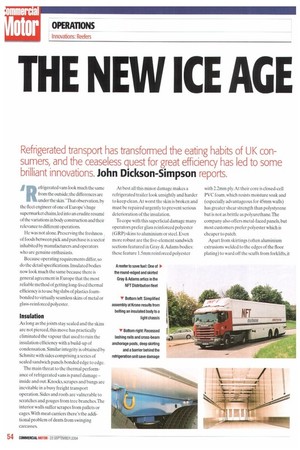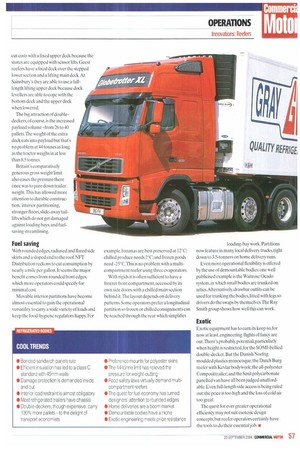THE NEW ICE AGE
Page 54

Page 55

Page 56

Page 57

If you've noticed an error in this article please click here to report it so we can fix it.
Refrigerated transport has transformed the eating habits of UK con sumers, and the ceaseless quest for great efficiency has led to some brilliant innovations. John Dickson-Simpson reports.
iR efrigerated vans look much the same from the outside; the differences are under the skin."That observation, by the fleet engineer of one of Europe's huge supermarket chains. led into an erudite resume of the variations in body construction and their relevance to different operations. He was not alone. Preserving the freshness , of foods between pick and purchase is a sector inhabited by manufacturers and operators who are genuine enthusiasts. Because operating requirements differ, so do the detail specifications. Insulated bodies now look much the same because there is general agreement in Europe that the most reliable method of getting long-lived thermal efficiency is louse big slabs of plastics foambonded to virtually seamless skins of metal or glass-reinforced polyester.
Insulation As long as the joints stay sealed and the skins are not pierced, this move has practically eliminated the vapour that used to ruin the insulation efficiency with a build-up of condensation. Similar integrity is obtained by Schmitz with sides comprising a series of sealed sandwich panels bonded edge to edge. The main threat to the thermal performance of refrigerated vans is panel damage — inside and out. Knocks, scrapes and bangs are inevitable in a busy freight transport operation. Sides and roofs are vulnerable to scratches and gouges from tree branches.The interior walls suffer scrapes from pallets or cages. With meat carriers there's the additional problem of dents from swinging carcasses. At best all this minor damage makes a refrigerated trailer look unsightly and harder to keep clean. At worst the skin is broken and must be repaired urgently to prevent serious deterioration of the insulation. To cope with this superficial damage many operators prefer glass reinforced polyester (GRP) skins to aluminium or steel. Even more robust are the five-element sandwich sections featured in Gray &Adams bodies: these feature 1.5mm reinforced polyester with 2.2mm ply At their core is closed-cell PVC foam. which resists moisture soak and (especially advantageous for 45min walls) has greater shear strength than polystyrene but is not as brittle as polyurethane. The company also offers metal-faced panels. but most customers prefer polyester which is cheaper to patch. Apart from skirtings (often aluminium extrusions welded to the edges of the floor plating) to ward off the scuffs from forklifts,it is common to specify rubbing strips along the walls.These are usually pierced steel strips such as Load Lok for anchoring lashing straps and crossbars.
These strips (top-hat pressings standing proud by 10-12mm) not only help protect the walls but also ensure there is a side gap that assists circulation of cold air. However, operators sometimes find the holes in the lashing strips snag on pallet loads (especially cartons) and that hooks on straps slightly increase gaps between pallet stacks.
Recessed To avoid these problems anchorage strips are recessed in grooves moulded along the walls. This is easily done with the 60mm-thick walls which have become more common since the maximum permissible body width was raised to 2,600mm, but Tesco uses recessed Load Lok even with 45mm walls. Operators who want a series of vertical slotted racks to take removable crossbeams to carry a second tier of pallets almost always have them recessed.
Bonded sandwich panel construction is thermally efficient enough to meet the class C ATP heat gain standard of 0.4Wr of temperature difference even with 45mm walls and a 100mm floor and roof.This is certainly adequate for comparatively short runs in the UK, although for longer trips there is a useful extra margin to be gained from 60rranwalls,which comfortably provide the minimum desirable interior width of 2,460mm.
Incidents of fork-lifts running into front bulkheads justify a stout barrier.This is a standard feature of Solomon refrigerated vans, for example.The space made by a bulkhead barrier also gives a front-end refrigeration unit a head start in getting cold air to circulate over the load. Even with an undermount refrigeration unit a barrier is a useful protector and no interior length need be wasted if the bulkhead is curved, leaving an air gap behind the barrier.
Buffers Damage can also be caused when backing up against loading bays. Deep rubber buffers are a must —some operators also fit bolt-on steel corner buffers. However, there must be enough strength in the understructure to take the shocks directly, by diagonal struts. straight to the chassis or running-gear subframe.
Insulated bodies are inherently very rigid. This opens the way to chassisless construction, which in turn allows the floor to be made a bit lower, improving headroom.This is of most interest to Continental operators who have to contend with a 4.0m overall height limit.
Hoped-for weight savings with chassisless reefers often fail to materialise because of the reinforcement that has to be built into the floor structure to spread point loads at the kingpin, landing legs and running gear. For this reason I here's a trend towards clamping or screwing an insulated box to a light and slim chassis.
When height is still precious the neck of the chassis can be recessed into the sandwich floor, with a little loss of thermal efficiency.This is done by Krone. for example, but it's not necessary for UK operation.What's more, the absence of a meaningful height restriction in the UK gives economic scope for double-deck trailers without recourse to deep wheelboxes (although they do usually need small wheels and a step frame). Here the front runners are Gray & Adams and Montracon.
Double-deck arrangements vary to suit the job. Some operators,such asTesco, are able to cut costs with a fixed upper deck because the stores are equipped with scissor lifts.Geest reefers have a fixed deck over the stepped lower section and a lifting main deck. At Sainsbury's they are able to use a fulllength lifting upper deck because dock levellers are able to cope with the bottom deck and the upper deck when lowered.
The big attraction of doubledeckers, of course, is the increased payload volume—from 26 to 40 pallets. The weight of the extra deck eats into payload but that's no problem at 44 tonnes as long as the tractor weighs in at less than 8.5 tonnes.
Britain's comparatively generous gross weight limit also eases the pressure there once was to pare down trailer weight. This has allowed more attention to durable construction, interior partitioning, stronger floors, slide-away taillifts which do not get damaged against loading bays, and fuelsaving streamlining.
Fuel saving
With rounded edges, radiused and flared side skirts and a sloped end to the roof, NET Distribution reckons to cut consumption by nearly a mile per gallon. It seems the major benefit comes from rounded front edges, which more operators could specify for minimal cost.
Movable interior partitions have become almost essential to gain the operational versatility to carry a wide variety of loads and keep the food-hygiene regulators happy. For example, bananas are best preserved at 12°C; chilled produce needs 2°C; and frozen goods need -25°C.This is no problem with a multicompartment reefer using three evaporators.
With rigids it is often sufficient to have a freezer front compartment, accessed by its own side doors, with a chilled main section behind it.The layout depends on delivery patterns. Some operators prefer a longitudinal partition so frozen or chilled consignments can be reached through the rear which simplifies loading-bay work. Partitions now feature in many local delivery trucks, right down to 3.5-tonners on home delivery runs.
Even more operational flexibility is offered by the use of demountable bodies: one well publicised example is the Waitrose Ocado system, in which small bodies are trunked on artics.Alternatively.drawbar outfits can be used for trunking the bodies, fitted with legs so drivers do the swaps by themselves.The Ray Smith group shows how well this can work.
Exotic
Exotic equipment has to earn its keep so, for now at least, engineering flights of fancy are out.There's probably potential particularly when height is restricted, for the SOMI-bellied double-decker. But the Danish Norftig moulded plastics monocoque;the Dutch Burg reefer with Kevlar bodywork; the all-polyester Composittrailer; and the Smit polycarbonate panelled van have all beenjudged unaffordable. Even full-length side access is being ruled out: the price is too high and the loss of cold air too great.
The quest for ever greater operational efficiency may not suit esoteric design concepts, but reefer operators certainly have the tools to do their essential job. •




























































































































































































